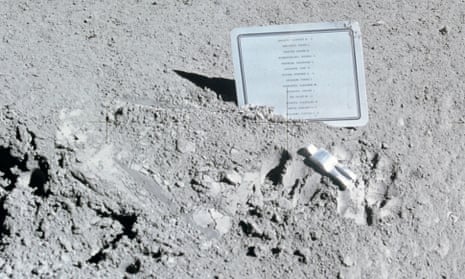More than half a century of lunar exploration has left its mark on the moon. What Edwin “Buzz” Aldrin described as the “magnificent desolation” of the relentlessly grey surface is littered with clapped-out robots, spacecraft parts, moon buggies (including one with a bible on the dashboard) and technical equipment.
Scattered around the Apollo landing sites are other items that were never meant to come home: a falcon’s feather, a javelin, bags of human waste, a family photo and an aluminium figure, the Fallen Astronaut, which lies on its side near a plaque bearing the names of 14 men who died in the pursuit of space exploration.
In all, the lunar junkyard holds nearly 200 tonnes of human objects. The dusty remains of five Saturn V rocket stages from the Apollo missions are the heaviest single items. Then there are the wreckages of spacecraft that smashed, or were crashed intentionally at the end of their missions, into the lunar surface. There are a dozen 1960s Soviet Luna probes; nearly twice as many US Rangers, Lunar Orbiters, Surveyors and more recent observatories; at least four Japanese spacecraft, and other robots sent from Europe, China and India. In April, the mangled remains of the first private moon mission, Israel Aerospace Industries’ Beresheet probe, became the latest addition when the lander’s gyroscopes failed.
More striking are those that met a more gentle end. Besides all the wreckages strewn across the moon are robotic landers and rovers that simply fell silent, their batteries spent or their hardware worn out. The Luna 9, the first spacecraft to achieve a soft landing, is there on the western edge of the near side of the moon. So is the Soviets’ magnificent, eight-wheeled Lunokhod 1, the first lunar rover, which in 1970 trundled around the Mare Imbrium, or Sea of Rains. Joining them in the lunar graveyard are Surveyor 1, the first of several American probes to land softly on the surface, and three moon buggies discarded by Apollo 15, 16 and 17. James Irwin, an Apollo 15 astronaut, left a bible on the dashboard of his mission’s buggy. The most recent rover to shut down on the moon was China’s Yutu, or Jade Rabbit, which has not been heard from since 2015.
Beyond the crashed, the ditched and the broken down are pieces of equipment and personal effects that astronauts left behind. The least charming are 96 bags for poo, urine and vomit that scientists, being scientists, are keen to get their hands on should the opportunity arise. More difficult to find will be the two golf balls that the Apollo 14 astronaut Alan Shepard hit for “miles and miles” and the metal rod, described by Nasa as a “javelin”, lobbed by Edgar Mitchell, the sixth man on the moon.
The crew of Apollo 15 carried an 8.5cm-tall aluminium figure to the moon. Created by the Belgian artist Paul Van Hoeydonck, the Fallen Astronaut was laid on its side with a plaque listing the names of astronauts and cosmonauts who died during the space race. At the end of Apollo 15’s final moonwalk, David Scott pulled out a falcon’s feather and a hammer and demonstrated Galileo’s theory that in the absence of air resistance, different objects fall at the same rate. The items are still there, along with 12 pairs of boots; one hundred $2 bills taken into space as good luck charms; a small gold olive branch left by Neil Armstrong as a symbol of peace; and a family photo placed on the ground by Charles Duke, the Apollo 16 astronaut who in 1972 became the 10th and youngest person to walk on the moon.
There is an abundance of technical junk there, too. The Apollo landing sites are littered with cameras, power packs, tongs, drills, towels, brushes, rakes and trenching tools, and scientific experiments that measured dust, seismic vibrations and the solar wind. Some of the artefacts still serve a scientific purpose. Retroreflectors installed on the moon by the Apollo astronauts and the Lunokhod 1 and 2 missions have been used to measure the Earth-moon distance with laser beams for the past 50 years.
The parts and pieces that dot the surface are only the most physical remnants of humanity’s intimate encounter with the moon. Less enduring are the marks in the ground, the footprints first made 50 years ago.










